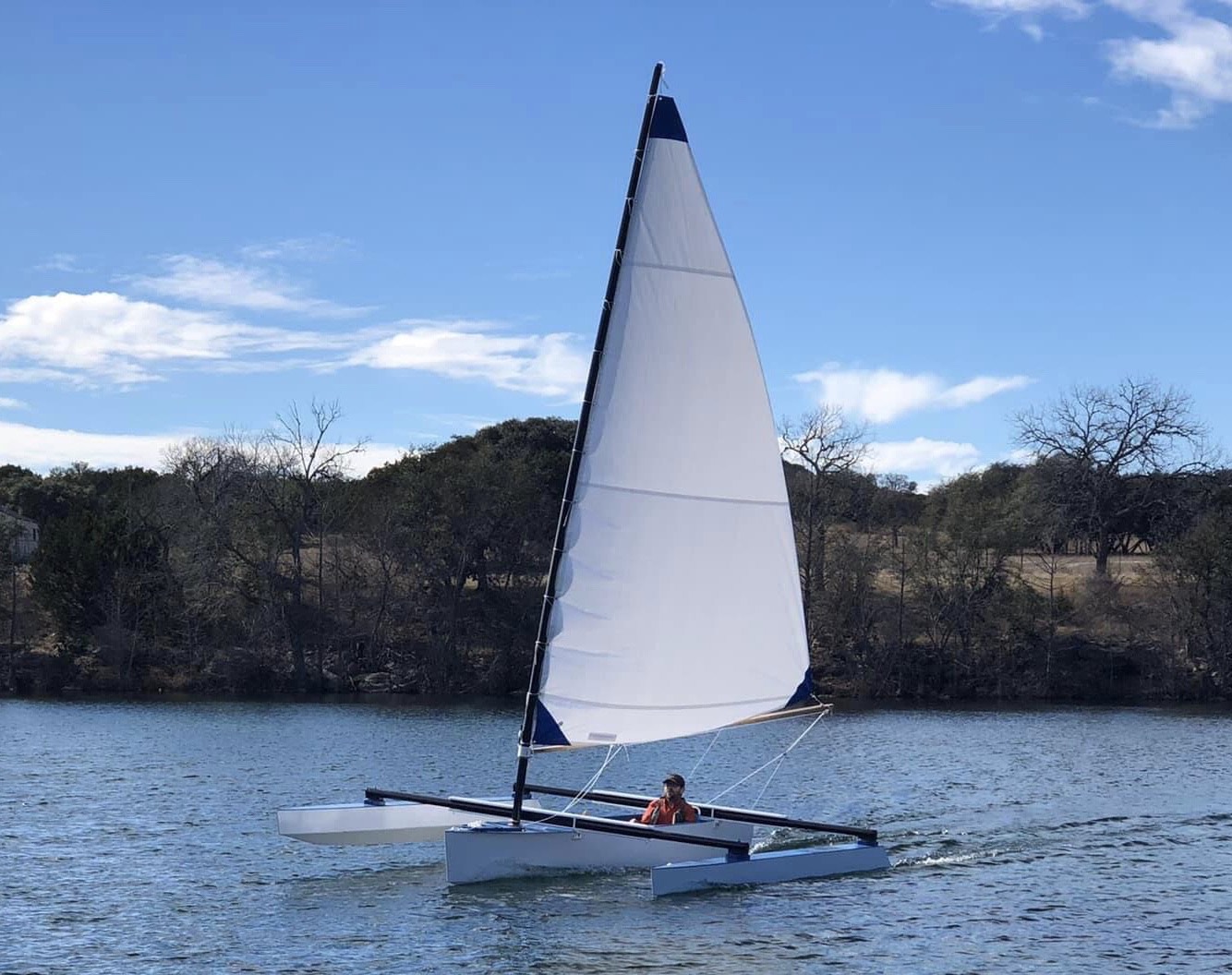Designer Spotlight: Frank Smoot
How I went from not knowing squat about boats (or sailing) -- to designing a little trimaran I can’t pry my friends out of.
It all started in 2009.
I was in the Gulf Of Mexico, doing a “speed test” in my new kayak. I managed 6 mph…for about 100 feet.
Not far away, I saw a small Sunfish sailboat. Figured I’d paddle over and go check it out. Never got anywhere near it. I’m paddling my arms off, he’s just sitting there sailing lazily – yet leaving me WAY behind.
In that moment, I knew I wanted to sail.
I set out to build my own sailboat.
First attempt: A pair of kayaks connected by 2x2s with a (very) makeshift sail and rudder. A catamaran…sort of. It worked…sort of.
Next attempt: Rigged one kayak with sail, amas, rudder – all very makeshift. Wet and not quick, but still encouraging progress.
Ultimately I wanted something quicker and drier, so I designed and built my first boat, called “No Commotion” because it sailed so smoothly. The verdict: Quick enough, but not nimble enough.
A dozen designs and 8 years later...
After a dozen subsequent designs and learning experiences over 8 years, designs got much better through constant building, redesigning and improving.
Eventually I found a design that “checked all the boxes.” It was a boat I built for my wife, and that hull – known as “Laura’s Boat” - seemed perfect.

Laura's boat, the inspiration behind the design known as "Slingshot."
I then continued to make numerous improvements over the years, including:
- mast height, weight, material
- mast step
- stayed vs unstayed rig
- boom length, weight, attachment points for sail, mainsheet
- sail attachment to mast
- sail shape, sail material
- batten orientation
- hull shape (a biggie)
- ama length, ama shape
- aka length, aka construction
- aka attachment to main hull
- aka attachment to amas
- folding vs fixed akas
- horizontal vs vertical folding akas
- hull balance
- COE (center of effort) vs CLR (center of lateral resistance)
- rudder size
- rudder remote steering
- rudder lift/lower remote control
- leeboard size, shape, location, pivot point, friction
- seat location (single seater vs tandem seating)
- hull design nimbleness vs top speed
- rocker optimization
- rigging for an outboard motor
Meet SLINGSHOT
I’ve used that same hull shape from Laura's Boat for the designs that later became the Slingshot 16 Solo, Slingshot 16 Tandem, and Slingshot 19. Here’s my Slingshot 16 solo doing 13 mph in moderate air. Quick AND dry!
The Slingshot 16 Tandem hull is 2” wider than the Solo. The 19’ version is a bit quicker, can carry more sail, and carries two people better. It’s also a bit better for a stayed mast. But for simplicity of construction and handling at age 70+, I prefer the 16-footers.
Why so many 16’ hulls? Because (a) there’s no need to register a 16’ sailboat in FL, and (b) I can make the hulls from two 8’ sheets of ply.
Here are a few shots of a nice Slingshot 16 build by Will Robertson, photos are his:



A few words about how I personally build my boats:
To avoid dumping a bundle on “test” designs, I use cheap (waterproof) lauan to build my hulls. I only need them to last a few years, so why go for $$$ okoume?
I use ¼” “sandply” from Ecuador for the decks of main hull and amas. Light, sturdy, cheap.
I apply 6 oz glass (two epoxy coats) over the hull exterior, doubled in the hull center, and another layer in cockpit. I use 4 oz glass on the deck and on the amas.
The entire exterior is epoxied, as is the interior floor and bilges. I just apply 2 coats of polyurethane varnish on non-horizontal interior surfaces.
My original ama design worked so well from the start that I‘ve stuck with it.
The akas were originally one-piece aluminum tubes. They worked fine, but lazy me wanted to arrive at the launch with a fully assembled boat. So I experimented with folding akas. Horizontal folding works best.
Frank Smoot boat plans ON SALE now
Frank is currently offering his designs on sale for 20% off to coincide with Duckworks Labor Day sale!
Frank's plans are beginner-friendly. He includes an extremely detailed construction manual including more than 280 photos detailing the complete building process, with thorough explanatory text. He also includes a separate drawings manual with dozens of superbly detailed, multicolor CAD drawings by Jerome Delaunay showing every construction detail with crystal clarity. Frank offers great one-on-one support via email too, and is always eager to talk with builders and answer any questions.
Check out his plans linked below. Don't miss the "Additional Information" tab on each plan page that has full specs and info to help you know what to expect with the build.
Recent Posts
-
Bestselling Boat Plan Designers of 2024
Fun fact: In 2024, you all collectively purchased over 2,500 boat plans from Duckworks! (That's 20 …Jan 25th 2025 -
A New Chapter in Duckworks History
Hi everyone, Katie here to give you an update on what's happening behind the scenes here at Duckwork …Sep 24th 2024 -
Designer Spotlight: Frank Smoot
How I went from not knowing squat about boats (or sailing) -- to designing a little trimaran I can’ …Aug 28th 2024




